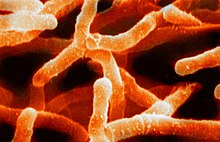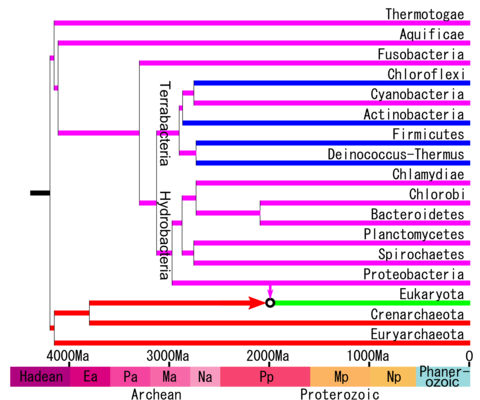Terrabacteria — разлика између измена
. |
(нема разлике)
|
Верзија на датум 7. новембар 2023. у 16:43
| Terrabacteria | |
|---|---|

| |
| Scanning electron micrograph of Actinomyces israelii (Actinomycetota) | |
| Научна класификација | |
| Домен: | Bacteria |
| (нерангирано): | Terrabacteria Battistuzzi et al., 2004, Battistuzzi & Hedges, 2009 |
| Razdeli | |
| Синоними | |
| |
Један корисник управо ради на овом чланку. Молимо остале кориснике да му допусте да заврши са радом. Ако имате коментаре и питања у вези са чланком, користите страницу за разговор.
Хвала на стрпљењу. Када радови буду завршени, овај шаблон ће бити уклоњен. Напомене
|
Terrabacteria je takson containing approximately two-thirds of prokaryote species, including those in the gram positive phyla (Actinomycetota and Bacillota) as well as the phyla "Cyanobacteria", Chloroflexota, and Deinococcota.[1][2]
Terrabacteria was proposed in 2004 for Actinomycetota, "Cyanobacteria", and Deinococcota[1] and was expanded later to include Bacillota and Chloroflexota.[2] Other phylogenetic analyses [3][4][5] have supported the close relationships of these phyla. Most species of prokaryotes not placed in Terrabacteria were assigned to the taxon Hydrobacteria,[2] in reference to the moist environment inferred for the common ancestor of those species. Some molecular phylogenetic analyses [6][7] have not supported this dichotomy of Terrabacteria and Hydrobacteria, but the most recent genomic analyses,[4][5] including those that have focused on rooting the tree,[4] have found these two groups to be monophyletic.[4]
Terrabacteria and Hydrobacteria were inferred to have diverged approximately 3 billion years ago, suggesting that land (continents) had been colonized by prokaryotes at that time.[2] Together, Terrabacteria and Hydrobacteria form a large group containing 97% of prokaryotes and 99% of all species of Bacteria known by 2009, and placed in the taxon Selabacteria, in allusion to their phototrophic abilities (selas = light).[8] Currently, the bacterial phyla that are outside of Terrabacteria + Hydrobacteria, and thus justifying the taxon Selabacteria, are debated and may or may not include Fusobacteria.[2][4]
The name “Glidobacteria” [9] included some members of Terrabacteria but excluded the large gram positive groups, Bacillota and Actinomycetota, and is not supported by molecular phylogenetic data.[1][2][3][6][7][4][5] Moreover, the article naming Glidobacteria [9] did not include a molecular phylogeny or statistical analyses and did not follow the widely-used three-domain system. For example, it claimed that eukaryotes split from Archaea very recently (~900 Mya), which is contradicted by the fossil record,[10] and that lineage of eukaryotes + Archaea was nested within Bacteria as a close relative of Actinomycetota.
Filogenija
Filogenetsko stablo prema filogenetskim analizama Batistucija i Hedžesa (2009) je navedeno ispod i sa kalibracijom molekularnog sata.[1][2]

Nedavne molekularne analize su otkrile otprilike sledeće odnose uključujući i druge tipove, čiji su odnosi bili neizvesni.[11][12][13][14][15][16]
| Terrabacteria |
| ||||||||||||||||||||||||||||||||||||||||||||||||||||||||||||||||||||||||||||||||||||||||||||||||||||||||||||||||||||||||||||||||||||||||||||||||
S druge strane, Koleman et al.On the other hand, Coleman et al.[4] su imenovali kladu koja se sastoji od Thermotogota, Deinococcota, Synergistota i koja je srodna sa DST, a osim toga analiza sugeriše da ultra-male bakterije (CPR grupa) mogu pripadati kladi Terrabacteria koja je bliže povezana sa Chloroflexota. Prema ovoj studiji, razdeo Aquificota koji se ponekad uključuje spada u Hydrobacteria, a razdeo Fusobacteriota se može pripadati i Terrabacteria i Hydrobacteria. Rezultat je bio sledeći:[4]
| Terrabacteria |
| ||||||||||||||||||||||||||||||||||||||||||||||||
Reference
- ^ а б в г Battistuzzi FU, Feijao A, Hedges SB (новембар 2004). „A genomic timescale of prokaryote evolution: insights into the origin of methanogenesis, phototrophy, and the colonization of land”. BMC Evolutionary Biology. 4: 44. PMC 533871
 . PMID 15535883. doi:10.1186/1471-2148-4-44.
. PMID 15535883. doi:10.1186/1471-2148-4-44.
- ^ а б в г д ђ е Battistuzzi FU, Hedges SB (фебруар 2009). „A major clade of prokaryotes with ancient adaptations to life on land”. Molecular Biology and Evolution. 26 (2): 335—343. PMID 18988685. doi:10.1093/molbev/msn247
 .
.
- ^ а б Bern M, Goldberg D (мај 2005). „Automatic selection of representative proteins for bacterial phylogeny”. BMC Evolutionary Biology. 5 (1): 34. PMC 1175084
 . PMID 15927057. doi:10.1186/1471-2148-5-34.
. PMID 15927057. doi:10.1186/1471-2148-5-34.
- ^ а б в г д ђ е ж Coleman GA, Davín AA, Mahendrarajah TA, Szánthó LL, Spang A, Hugenholtz P, et al. (мај 2021). „A rooted phylogeny resolves early bacterial evolution”. Science. 372 (6542): eabe0511. PMID 33958449. S2CID 233872903. doi:10.1126/science.abe0511.
- ^ а б в Léonard RR, Sauvage E, Lupo V, Perrin A, Sirjacobs D, Charlier P, et al. (фебруар 2022). „Was the Last Bacterial Common Ancestor a Monoderm after All?”. Genes. 13 (2): 376. PMC 8871954
 . PMID 35205421. doi:10.3390/genes13020376
. PMID 35205421. doi:10.3390/genes13020376  .
.
- ^ а б Hug LA, Baker BJ, Anantharaman K, Brown CT, Probst AJ, Castelle CJ, et al. (април 2016). „A new view of the tree of life”. Nature Microbiology. 1 (5): 16048. PMID 27572647. S2CID 3833474. doi:10.1038/nmicrobiol.2016.48
 .
.
- ^ а б Zhu Q, Mai U, Pfeiffer W, Janssen S, Asnicar F, Sanders JG, et al. (децембар 2019). „Phylogenomics of 10,575 genomes reveals evolutionary proximity between domains Bacteria and Archaea”. Nature Communications. 10 (1): 5477. Bibcode:2019NatCo..10.5477Z. PMC 6889312
 . PMID 31792218. doi:10.1038/s41467-019-13443-4.
. PMID 31792218. doi:10.1038/s41467-019-13443-4.
- ^ Battistuzzi FU, Hedges SB (2009). „Eubacteria”. Ур.: Hedges SB, Kumar S. The Timetree of Life. New York: Oxford University Press. стр. 106—115.
- ^ а б Cavalier-Smith T (јул 2006). „Rooting the tree of life by transition analyses”. Biology Direct. 1 (1): 19. PMC 1586193
 . PMID 16834776. doi:10.1186/1745-6150-1-19.
. PMID 16834776. doi:10.1186/1745-6150-1-19.
- ^ Knoll AH (2003). Life on a Young Planet : The First Three Billion Years of Evolution on Earth - Updated Edition. ISBN 0-691-00978-3. OCLC 1303471348.
- ^ Anantharaman K, Brown CT, Hug LA, Sharon I, Castelle CJ, Probst AJ, et al. (октобар 2016). „Thousands of microbial genomes shed light on interconnected biogeochemical processes in an aquifer system”. Nature Communications. 7: 13219. Bibcode:2016NatCo...713219A. PMC 5079060
 . PMID 27774985. doi:10.1038/ncomms13219.
. PMID 27774985. doi:10.1038/ncomms13219.
- ^ Matheus Carnevali PB, Schulz F, Castelle CJ, Kantor RS, Shih PM, Sharon I, et al. (јануар 2019). „Hydrogen-based metabolism as an ancestral trait in lineages sibling to the Cyanobacteria”. Nature Communications. 10 (1): 463. Bibcode:2019NatCo..10..463M. PMC 6349859
 . PMID 30692531. doi:10.1038/s41467-018-08246-y.
. PMID 30692531. doi:10.1038/s41467-018-08246-y.
- ^ Ji M, Greening C, Vanwonterghem I, Carere CR, Bay SK, Steen JA, et al. (децембар 2017). „Atmospheric trace gases support primary production in Antarctic desert surface soil”. Nature. 552 (7685): 400—403. Bibcode:2017Natur.552..400J. PMID 29211716. S2CID 4394421. doi:10.1038/nature25014
 .
.
- ^ Tahon G, Tytgat B, Lebbe L, Carlier A, Willems A (јул 2018). „Abditibacterium utsteinense sp. nov., the first cultivated member of candidate phylum FBP, isolated from ice-free Antarctic soil samples”. Systematic and Applied Microbiology. 41 (4): 279—290. PMID 29475572. S2CID 3515091. doi:10.1016/j.syapm.2018.01.009.
- ^ Rinke C, Schwientek P, Sczyrba A, Ivanova NN, Anderson IJ, Cheng JF, et al. (јул 2013). „Insights into the phylogeny and coding potential of microbial dark matter”. Nature. 499 (7459): 431—437. Bibcode:2013Natur.499..431R. PMID 23851394. S2CID 4394530. doi:10.1038/nature12352
 .
.
- ^ Eloe-Fadrosh EA, Paez-Espino D, Jarett J, Dunfield PF, Hedlund BP, Dekas AE, et al. (јануар 2016). „Global metagenomic survey reveals a new bacterial candidate phylum in geothermal springs”. Nature Communications. 7: 10476. Bibcode:2016NatCo...710476E. PMC 4737851
 . PMID 26814032. doi:10.1038/ncomms10476.
. PMID 26814032. doi:10.1038/ncomms10476.
